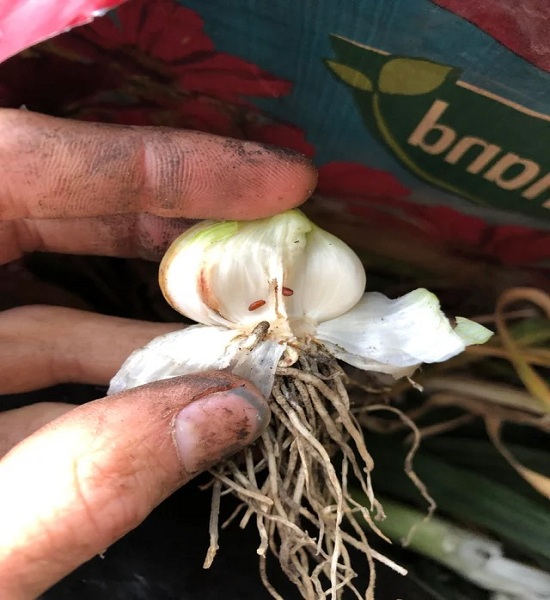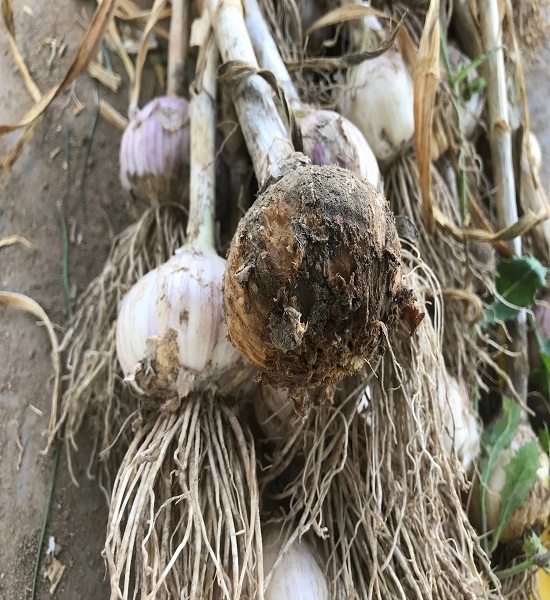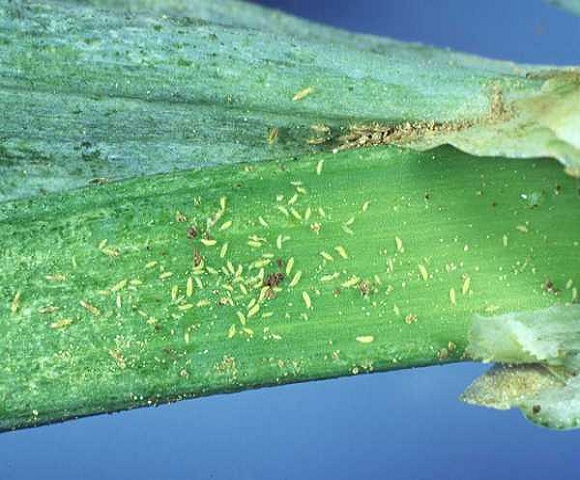As a bulb, garlic has a strong odor and pungent flavor. Due to this, it stands to reason that most pests will avoid it. It is also a common companion plant for roses, peppers, and tomatoes in gardens because it helps keep pests away.
But if we find it tasty, why shouldn’t the bugs? Some pests are resistant to the sulfuric pungent of garlic. This article will discuss the top 5 pests that can cause damage to this fragrant Allium species.
Bulb Mites
Dry bulb mites are one of the most serious and pervasive garlic pests.
Mature dry bulb mites look like tiny, coiled worms and measure 0.3 millimeters or less in length.
They complete their entire life cycle in about 2 weeks, so you can see them at any time of year in their various stages (egg, larva, nymph, and adult). But only if you have a good magnifying glass.
These mites hibernate underground or inside garlic cloves during the winter.
True to their name, dry bulb mites eat only on bulbs: garlic, tulip, onion, and lily.
They live between garlic clove layers or inside leaves and cause galls by feeding from within. Other indicators of dry bulb mite infestation include bent, stunted leaves and slow growth.
Rhizoglyphus bulb mites, especially R. echinopus, also feed on garlic. These bulb mites resemble squishy, moist pearls and are 0.5 to 1 mm long.
This mite, like the dry bulb mite, takes 2 weeks to complete its life cycle. It lays white, oval-shaped eggs.
Larvae have only three sets of legs when they hatch, while nymphs and adults have four.
Bulb mites cause stunting in plants, which may go unnoticed until the stored cloves rot.
Both types of bulb mites should be suspected if you find brown spots and decay on the packaging and cloves.
When the females of these pests lay their eggs on your plant’s leaves, dozens of ravenous larvae will hatch and feast on your crop.
How to Control Bulb Mites
Since bulb mites are immune to chemical pesticides, the best way to control them is through cultural, predatory, and organic methods.
You should rotate your crops and not plant alliums in the same area again for at least four years because mites can survive in the soil for multiple growing seasons.
Don’t use the same raised bed year after year to grow garlic. As an alternative, try growing garlic one year and carrots the next, and so on.
If you want to grow alliums again, wait at least four years before planting them in the same raised bed or other planting area, or even in the same soil.
It’s also not a good idea to plant Alliums there if you’ve recently grown mite-hosting crops like brassicas, corn, wheat, or grass.
In order to reduce the likelihood of an infestation, the Integrated Pest Management Program at the University of California suggests soaking seed cloves in hot water at 130°F for 10-20 minutes prior to planting.
They also mention that this can inhibit germination and that water temperatures above 132°F can damage clove tissue, so keep a cooking thermometer on hand.
To control pest populations, you can release predatory insects like the rove beetle (Dalotia coriaria) to eat unwanted pests. After removing and disposing of the diseased plant(s), you should release one or two live roving beetles per square foot of the affected area. These beetles will not harm your garden, they will only feed on bulb mites.

Leafminers
Tiny yellow and black flies called Phytomyza gymnostoma, which feed on alliums, lay tiny, curled white eggs on the undersides of leaves.
White-yellow, 8-millimeter-long maggots emerge from the eggs and bore into the leaves, devouring the tissue. They keep developing into a reddish-orange pupa that’s only 3.5 mm long.
They can even eat their way into the bulbs themselves.
Holes and wavy white lines on the stalks and leaves are telltale signs of these terrible pests.
How to Control Leafminers
Floating row covers can keep adult flies away from your crops if leafminers are a problem in your area.
When you plant in the spring, put them in right away. You can also use them during fall plantings because leafminer flies frequently seek out host Alliums to overwinter in, and you don’t want them to choose your garlic crop.
Reduce the number of leafminers by keeping the ground around your plants mulched and free of weeds.
And if you see the telltale white streak on a leaf anywhere in your garden, don’t hesitate to pull it off and throw it away.
Repeated inspections will help you identify and kill any remaining larvae before they can cause further harm to your plants.
When temperatures are high, leafminers can complete their life cycle in as little as two weeks, at which point the adults will typically lay more eggs.
The female parasitic wasp (Diglyphus isaea) seeks out leafminer larvae, paralyzes them, and then lays eggs on them. The newly hatched wasp larvae eat the leafminer larvae.
The wasp larvae will mature into adult parasitic wasps in a matter of weeks, at which point they will feast on even more leafminers and eventually wipe them out.

Nematodes
There are some nematodes that are actually beneficial to plants, but the garlic bloat nematode (Ditylenchus dipsaci) is not one of them.
These microscopic, flatworms live in the soil and spend about 21 days feeding on your garlic’s bulbs, stems, and leaves before dying.
Damage from feeding results in yellowing and eventual wilting of the plant’s foliage. When infected, the ruined bulbs swell up then soften and become a haven for fungi.
How to Control Nematodes
Dead Allium plant material can serve as a host for nematodes, so it’s important to remove any such debris before planting.
If you plant Alliums in a given area one year, you shouldn’t plant anything else there for at least four years.
Nematodes also enjoy eating celery, parsley, hydrangeas, flower bulbs, and alfalfa, so it’s best to rotate plantings of these crops every year.
Avoid having host weeds like field thistle and hairy nightshade growing near your garlic; pests can thrive in these. They’ll gladly make the short journey to your prized bulbs from that location.
Furthermore, you should always wash and disinfect your gardening tools before and after use. While nematodes can’t travel far on their own, they can quickly spread to new areas if you use contaminated tools, gloves, or even the bottoms of your gardening shoes.
Alternatively, you can use an insecticide such as a spray containing a high concentration of neem oil to eliminate parasitic nematodes without harming beneficial insects.
1 teaspoon of neem oil and 1/2 teaspoon of dish soap can be added to 1 quart of warm water to create a homemade neem oil spray. Put the mixture into a spray bottle and give the affected plants a thorough soaking. Reapply once a week as needed.

Onion Maggots
Onion maggots (Delia antiqua) are large compared to nematodes, reaching lengths of about 1 centimeter, and they are mobile. At least, adult flies can.
Delia antiqua pupae hibernate underground during the cold season. But in the spring, they grow wings and become adult flies that will fly up to a mile to find your garlic plants and lay their eggs in the soil around them or sometimes on the leaves.
The maggots, or newly hatched larvae, will consume everything from the plant’s roots and bulbs to its stems and leaves.
The eggs like it when it is cooler, and they die when the first inch of soil gets to 95°F. Once the eggs hatch, the larvae will eat their way to the plant’s roots, killing them completely. Damage from onion maggots manifests initially as wilted or shriveled leaves.
Stick yellow cards around your garden to see if the flies show up. If you catch narrow-bodied, 5 to 7 millimeter long flies with humped backs, you’ll have to deal with maggots.
How to Control Onion Maggots
Crop rotation is the best way to stop onion maggots, which are the larvae of onion flies, from eating your garlic crop every year. Don’t plant Alliums in the same soil for two years in a row, and follow the rule about rotating them every four years.
Also, think about planting garlic in containers or raised beds. Onion flies don’t like containers as much as garden soil because the soil is loose and drains well.
You can also use a floating row cover soon after planting seeds or transplanting seedlings to discourage mature female onion flies from laying eggs, which resemble white rice grains.
As an extra safety measure, you could put diatomaceous earth around your plants to kill the soft-bodied larvae when they hatch. Apply again after it rains.
If you find any onion fly eggs, remove the affected soil and plants and spray the area with insecticide.
Choose a spray that contains spinosad if you prefer a natural way to get rid of them.

Thrips
These tiny bugs, which are less than 1 millimeter long, are all over the garden, and they really bother gardeners.
Onion thrips, Thrips tabaci, and Western flower thrips, Frankliniella occidentalis, feed on the juice in the leaves of garlic and other plants in the Allium genus.
Onion thrips are thin, orange, and see-through. They look a little bit like bees, but are much smaller at just over 1 mm long.
Western flower thrips are 1.5 mm long, thin, and yellow with a black line between their wings.
Both are very small, but you can still see them with the naked eye.
When thrips are present, the spots on the leaves will be white. They might also get a silvery color.
Thrips don’t kill plants right away, but they can do a lot of damage to a plant’s health over time, making it vulnerable to disease.
How to Control Thrips
As always, it’s best to rotate your crops and keep your garlic patch free of weeds. The thrips that live on weeds can easily move to your garlic plants.
Watering plants from above can also help keep them free of thrips, which like hot, dry places.
Once there are a lot of thrips, natural predators like green lacewings, ladybugs, parasitic wasps, minute pirate bugs, and helpful Sf nematodes are the best way to get rid of them.
To make sure there are enough healthy predators, plant a variety of vegetables that attract good bugs.
Leave the dandelions where they are in your yard. Lacewings like them, as well as the flowers of dill, coriander, and fennel.


